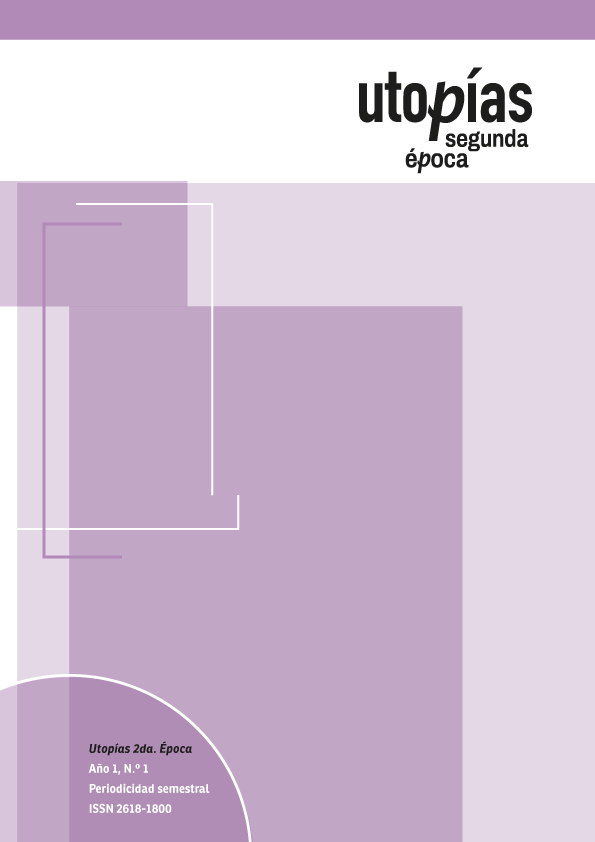Mental health and protection institutions The future of youth in protection
Main Article Content
Abstract
This article is the result of a research that seeks to elucidate the effects that institutionalization processes have on the mental health of young people who underwent protective measures during their adolescence in shelter homes, in a twenty-four-hour care modality, in the city of Paysandú, Uruguay.
It’s so, based on a qualitative research methodology, it is problematized based on the dialogue at the intersection of three relevant sources: scientific and regulatory production, the narratives of young people and the institutional perspective from the discourse of the authorities.
Of the main results obtained, the following stand out the institutional gaps in the responses and support in the expenditures of the protection system, added to the fact that once they graduate, there are no other inter-institutional and/or community networks that sustain, accompany and strengthen the processes that young people must face at the age of eighteen; also elucidating that they are processes that exceed the moment of institutionalization, encompassing the singular and contextual situations prior to admission. It is so this research aims to problematize the living conditions of young people as a consequence of these previous processes, once they reach the age of majority.
Downloads
Article Details

This work is licensed under a Creative Commons Attribution-NonCommercial-ShareAlike 4.0 International License.
Las ediciones no tienen cargos para las y los autores ni para las y los lectores, y se incita a las y los autores a depositar sus contribuciones en otros repositorios institucionales y temáticos, con la certeza de que la cultura y el conocimiento son un bien de todos y para todos. Utopías. Segunda época permite la reutilización luego de su edición (Post print) citando la autoría y la fuente original de su publicación. Su uso no puede ser con fines comerciales.
References
ALDEAS INFANTILES S.O.S URUGUAY (2016). El egreso de adolescentes y jóvenes del sistema de protección.
https://www.ohchr.org/Documents/Issues/Youth/AldeasInfantiles_SOS_Uruguay.pdf
ARDILA GÓMEZ, S. y STOLKINER, A. (2012). Conceptualizando la salud mental en las prácticas. Consideraciones desde el pensamiento de la medicina social/salud colectiva latinoamericanas. Vertex Revista Argentina de Psiquiatría, 23 pp. 57–67.
BANG, C. (2014). Estrategias comunitarias en promoción de salud mental: Construyendo una trama conceptual para el abordaje de problemáticas psicosociales complejas. Revista Psicoperspectivas: Individuo y sociedad, 13(2), pp. 109–120. https://www.psicoperspectivas.cl/index.php/psicoperspectivas/article/view/399
BARRIOS TECHERA, L. & HERNÁNDEZ LÓPEZ, M. (2020). La vulneración de derechos en la infancia y la adolescencia: recorte y economización de lo social en la protección social. Fronteras, 15 (2), pp.125–137.
CHAVES, M. (2010). Jóvenes, territorios y complicidades. Una antropología de la juventud urbana. Espacio Editorial.
DE SOUZA MINAYO, C. (2009). La artesanía de la investigación cualitativa. Lugar Editorial.
DOMÍNGUEZ, P., & SILVA BALERIO, D. (2014). Autonomía anticipada. Tramas y trampas del egreso de adolescentes institucionalizados por protección. UNICEF, La Barca.
http://www.unicef.org/uruguay/spanish/Autonomia_anticipada.pdf
FILARDO, V. (2009). Juventud como objeto, jóvenes como sujetos. Revista de Ciencias Sociales, 22(25), pp. 6–9.
https://www.scielo.cl/scielo.php?script=sci_arttext&pid=S0718- 22362018000300109
GALENDE, E. (2008). Desmanicomialización institucional y subjetiva. Psicoanálisis. Vol. xxx. (2/3). 395-427.https://www.psicoanalisisapdeba.org/descriptores/institucion/desmanicomializacion-nstitucional-y-subjetiva/
INAU (2008). Centros de atención integral para niños, niñas y/ o adolescentes. Nivel de atención I. Programa de evaluación y supervisión de centros de protección integral de tiempo completo. División convenios. Inédito.
INAU (2014). Centros de atención integral a niños, niñas y adolescentes. http://inau.gub.uy/index.php/ninerz/centros-de-atencionintegral-a-ninos-ninas-y-adolescentes
JARAMILLO, J. & RESTREPO, D. (2012). Concepciones de salud mental en el campo de la salud pública. Rev. Fac. Nac. Salud Pública 2012 30(2), pp. 202–211. https://revistas.udea.edu.co/index.php/fnsp/article/view/10764
MORTEO, A. (2015). La potencia de los cuerpos con psicofármacos: Adolescentes en hogares de protección de tiempo completo (Tesis de Maestría). Universidad de la República. Montevideo, Uruguay.
Observatorio de Derechos de la Niñez y Adolescencia en Uruguay (2018). Informe 2018. https://www.cdnuruguay.org.uy/noticias/informe-2018-observatorio-dederechos-de-ninez-y-adolescencia-del-uruguay/
ORGANIZACIÓN MUNDIAL DE LA SALUD (2011). Riesgos para la salud de los jóvenes. Nota descriptiva n.° 345. http://www.who.int/mediacentre/factsheets/fs345/es/index.html
RODRÍGUEZ, C. (2016). Lo insoportable en las instituciones de protección a la infancia. Azafrán.
SENA, S. (2015). La construcción de la historia en adolescentes institucionalizados. (Tesis de Maestría).
www.colibri.udelar.edu.uy/bitstream/123456789/7574/1/Sena,%20Sandra.pdf
SILVA BALERIO, D. (2017). Experiencia narrativa: adolescentes institucionalizados por protección. UOC.
STOLKINER A. y ARDILA, S. (2012). Conceptualizando la salud mental en las prácticas: consideraciones desde el pensamiento de la medicina social/salud colectiva latinoamericanas. Vertex- Revista Argentina de Psiquiatría, Vol. XXIII, pp. 57–67.
ULLOA, F. (2004). Entredichos: Fernando Ulloa / Luis Grieco. Relaciones, 241. http://www.chasque.net/frontpage/relacion/0406/entredichos_articulo.htm
UNICEF (1989). Convención sobre los derechos del niño. http://www.unicef.org/panama/spanish/convencion(3).pdf
UNICEF (2013). La situación de los niños, niñas y adolescentes en las instituciones de protección y cuidado de América latina y el Caribe. Protección de La Infancia, pp. 1– 67.
http://www.unicef.org/lac/La_situacion_de_NNA_en_instituciones_en_LAC_-_Sept_2013.pdf
VINAR, M. (2011). El enigma del traumatismo extremo. Notas sobre el trauma y la exclusión. Su impacto en la subjetividad. Revista Uruguaya de Psicoanálisis, 113, pp. 55–66.
http://www.apuruguay.org/apurevista/2010/16887247201111304.pdf
VOMMARO, P. (2019). Desigualdades, derechos y participación juvenil en América Latina: acercamientos desde los procesos generacionales. Revista Direito e Praxis 10(2), pp. 1192–1213. https://www.scielo.br/j/rdp/a/cyFbmbMdnWmpgbWp3wssjcp/?lang=es
